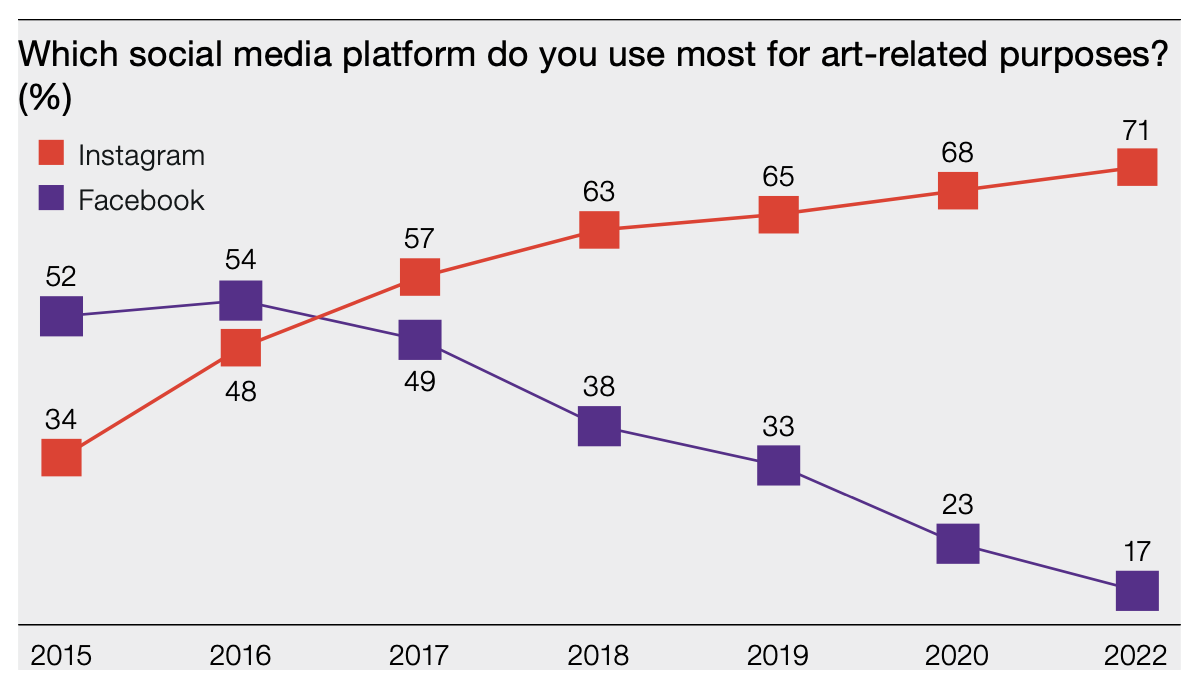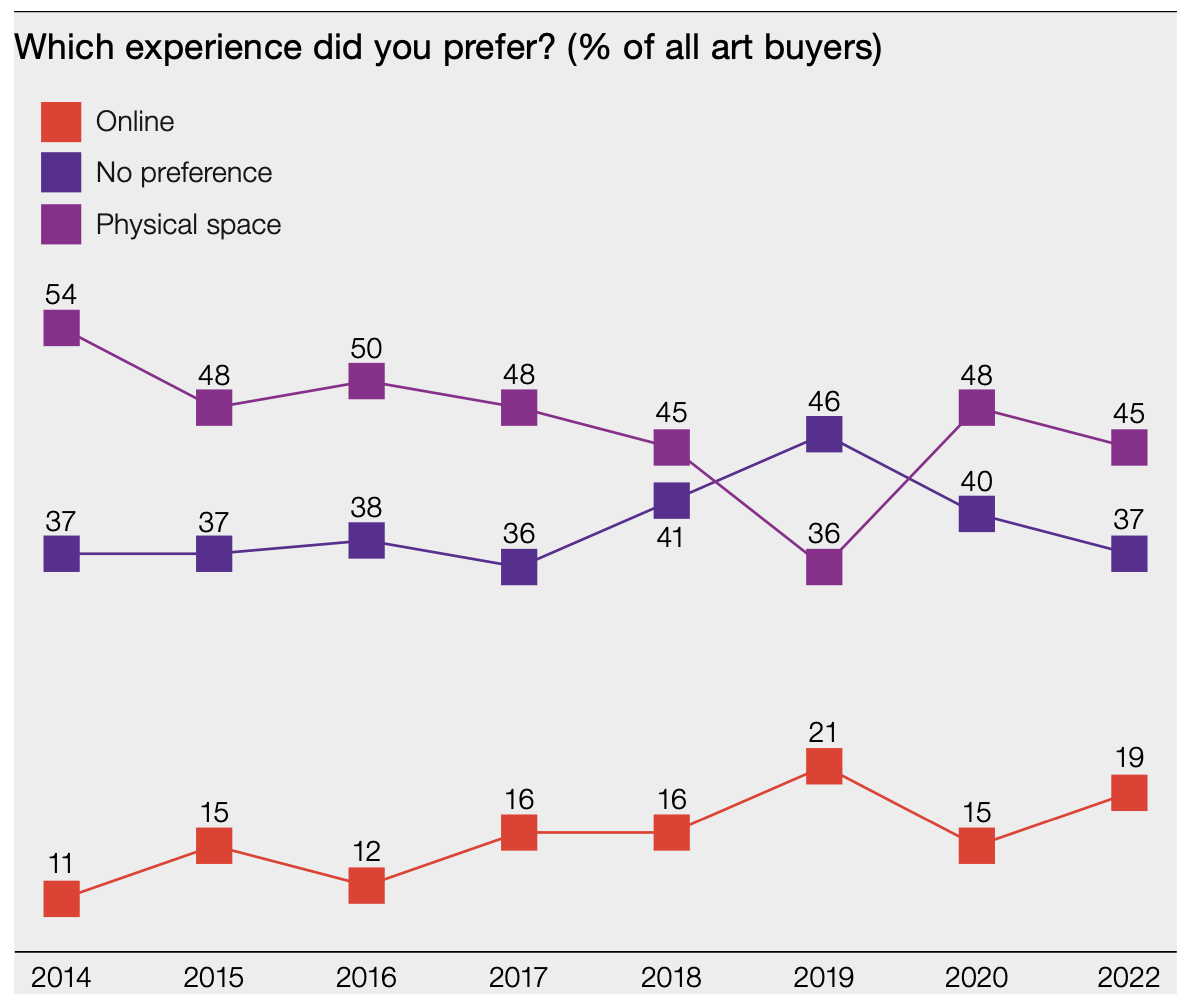The pandemic drastically changed the fine art market. Yesterday I shared these stats.
- 2/3 of all art buyers bought art online in 2021
- 8/10 people who bought online bought in the last 12 months
- 27% of art buyers will buy an NFT
When I started TAA in 2009, it was less than 10%. What a difference a decade makes.
Of course, just as many artists were scrambling to adjust, the market shifted again. NFTs took up all the oxygen in the media. A lot of mediocre digital art sold for a lot of money.
Sotheby’s art auctions grew 824% in 2020, but just 22% in 2021. NFTs then plummeted in 2022. Many artists – and many other online business owners – saw their own businesses that benefited from the 2020 online shift experience a massive drop in 2022.
It’s a confusing time to be an artist.
In the last few weeks I’ve been doing a deep dive with artists all over the world. What’s working in selling art? What’s not working? Why? What about NFTs?
I’ve had some time to process my initial reactions to the interviews and read the Hiscox 2022 Online Art Market Report. Today I’m sharing my Top 10 Tips for Selling Art in 2022 and beyond. Keep in mind that these tips are focused on what I’m increasingly calling Indie Fine Artists. Indie because the artists are not necessarily represented by an art gallery or major auction house. They have direct connections to their collectors, and make their own business decisions rather than letting the art industry dictate the meaning and value of their art.

10 tips for selling art in 2022 (and beyond)
1. Have something to say, and create art in series. Art sells best when you can see that the artist has more than skill. They have a vision, a point of view that is emotionally compelling. They want to move the world and aren’t afraid to create something original. A blunt truth is that art that merely replicates life or copies other work might land a deal with a big licensing company or retailer, but it won’t last. This is just as true in 2022 as it was in all previous years.
2. Nurture your core collectors. Artists who had strong relationships with their collectors before the pandemic thrived. Their collectors doubled down in the pandemic and kept buying. Kevin Kelly’s essay, 1,000 True Fans, has never been more relevant. The hardest sale to get is a new buyer. It’s easier to sell to your core collectors than it is to get a new one. Introversion is an excuse to avoid talking to people. It might be exhausting, but you need to nurture those relationships in order to have a long-lived art career. This doesn’t mean broadcasting your personal life on social media – it means connecting with people on a real level, which can certainly happen over email, text, and social…as well as in real life. Collectors want to know who you are and what your art is about. Give them that and the right people will support you for a long time.
3. Keep up with social media changes. 40% of art buyers say that social media influences what art they buy. This graphic is from Hiscox, about art buyer behavior.

Digging further into the Hiscox data and other sources, it’s obvious that the social media gold rush is on TikTok. Facebook is mostly dead for art collectors. Instagram is fully the king of fine art social unless and until TikTok topples IG. In younger collectors a surprising 26% are finding art on LinkedIn. I have a lot of questions about that last stat, and it needs more research.
Remember that big follower counts don’t matter. Connection does. You can have 1500 followers and sell a lot of art because they know you and love your art. Last week I spoke to an artist with 300k+ followers on Instagram who has only sold three small pieces in the last few months. Engage with your followers and build relationships with them.
4. Offline still matters a lot. Even though collectors are finally buying online, marketing works best when social and email are also used to help collectors know when and where to show up and see a piece, even in nontraditional spaces.
Doing a living room show, a studio visit, an open studio event, art parties and other events are increasingly more and more popular, especially for Indie Fine Artists.
Again, a graphic from Hiscox.

5. Try a virtual show. Several artists that I interviewed have done virtual shows via Zoom. Whether invited 1:1 chats with their favoriate collectors or small group shows, the artists got on live video chat with people, showed off their art, and made direct offers during. Now that pretty much everyone is comfortable with video chat these kinds of shows are gaining popularity with collectors who want to get to know artists from far away without traveling.
6. Do everything you can to show what the work looks like and guarantee its condition. Among the biggest challenges in selling art online are collector concerns over the appearance and condition of the work when it arrives. It’s not enough to share a straight-on cropped shot of the work out of context. Buyers need to know how big it is, what it looks like in different light and contexts, and even what the frames look like. There are many in situ apps that will allow you to preview the art in various ways, even virtually in 3D or in augmented reality.
Your sales pages will benefit from explaining how you package and ship your art, as well as any guarantees or refund policies. This will help collectors believe they can trust you and that the work will look as good in their living rooms as it will on your website.
7. Seriously consider NFTs in your artmaking and/or as a way of showing ownership, provenance, and value. While many now-famous NFTs aren’t necessarily of high artistic value, the fact that 27% of collectors say they plan to buy NFTs means that artists at least need to be educated on what they are and how they can be used to guarantee proof of ownership and provenance. NFT-aligned art also has a temporary advantage of value add due to market forces right now, although that may not be the case after a few years. We recently published a brief overview of what NFTs are and some of the challenges and concerns with NFTs.
Evergreen Suggestions for Selling Art
Some evergreen advice came up during our interviews. These suggestions help no matter what is happening in the economy or in the art market aggregate.
8. Invest in learning how to run a business, especially in learning how to sell. Of the artists we surveyed, most had never taken a class and only read one book, even though they were highly educated with MFAs or BFAs. Knowledgeable competition is actually quite low.
There are lots of books and resources for learning how to sell. At the risk of being completely self-serving, TAA has numerous books and courses. You don’t have to just take our word for it though, and I’d encourage you to learn from several different sources. Our perspective is just one and people have different learning styles and resonate with different teachers.
9. Observe the 50/50 Time rule. Of the time you’re working on your art business, at least 50% should be on marketing and building your audience. This is generally true for most successful artists I know. We’ve been writing and talking about the 50/50 Time rule since 2016.
10. Learn good time management and productivity skills. Know how long an average painting takes. Document how much time you spend marketing and what works. Use basic time blocking techniques to ensure you don’t get distracted. Take time to think about what you’re spending your time on and whether it’s working or needs to change. Charlie Gilkey, a good friend and productivity expert who works with creatives, did a timeless productivity webinar with me a few years ago that is still highly relevant.
Join us this Monday at 1 PM Pacific for a free webinar where I’ll talk about these ideas and more. There will be time for plenty of questions and answers. Join us here.
Also: If you want to join us for the next round of How to Sell Your Art Online 101, we start soon. You can learn more and sign up here.
Leave a Reply